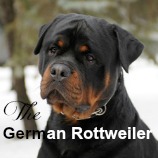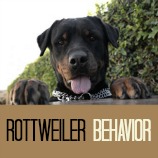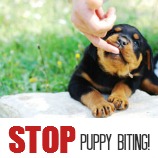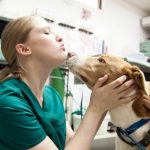
If you’d like to use the correct Germanic words when you’re training your Rottweiler, I’ve put together this page to help you get started.
In This Article You Will Read About
You’ll find a list of some of the most common German language dog training words/commands, what they mean in English, and a guide to help you pronounce them properly. In fact, everything you need to turn your Rottie into a bi-lingual dog is right here!
German Training Commands – When & Why To Use Them
In sports and activities such as Shutzhund, Tracking, Advanced Obedience, and so on, many dog owners and trainers like to use German dog commands – especially if they own GSDs, Rottweilers, or other similar breeds.
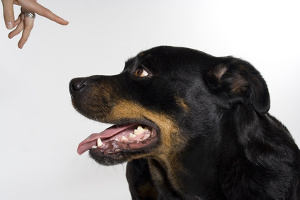
German commands are generally short and distinct, and because of the ‘sound’ of the language, they can seem more forceful than their English counterparts….
You can train your Rottweiler equally well using either language, but don’t try to use both languages though, pick one and stick with it!
Your pup is very intelligent, but he is likely to get confused if you switch back and forth between languages/words.
List Of German Popular Commands
There are plenty of different commands that you may want to work with your dog for. You may want to look at things like the word sit in German or what is German for lay down. These commands help you and your dog understand each other better. Not to mention you can improve their behavior more quickly.
| English Command | German Command | Pronounciation |
| Bad dog | Schlechter hund | sch-lek-ter hoond |
| Bark or Speak | Gib Laut | Geb-lowt |
| Bite | Packen | Pakken |
| Crate | Box | – as in English ‘box’ – |
| Come | Komm | Komm |
| Down | Platz | Plotts |
| Fetch | Bring or Bringen | – as in English ‘bring’ or ‘bring-en’ – |
| Go | Geh | gay |
| Go Out | Voraus | for-owss |
| Good dog | Braver Hund | Brahver hoond |
| Good/Well done | So ist’s brav | Zo ists brahv |
| Guard | Pass Auf | Pass Owf |
| Heel | Fuss | foos |
| Here | Hier | – as in English ‘here’ – |
| Jump | Hupf | Hup-f |
| No | Nein | Nine |
| Out/Drop It | Aus | Owss |
| Pay Attention/Watch | Achtung | Ahk-tung |
| Quiet | Ruhig | Roo-ig |
| Sit | Sitz | sets |
| Stand | Steh | shtay |
| Stay | Bleip | Bl-eye-p |
| Track | Such | Sook |
Puppies and dogs learn through repetition, and it’s important to be consistent with whatever words and language you decide to use. If you’ve bought a Rottweiler puppy who was imported from Germany, he will already have heard the German language and commands.
If you’ve bought an older, adolescent, or adult import then chances are good that he will be very familiar with German dog training commands and bonding/training will be more straightforward if you ‘speak his language’.
Puppies and dogs bought from the USA or the UK will most likely only know English words, but they will be able to learn German if you take it slowly and carefully.
If your dog is a pet and isn’t going to be taking part in advanced obedience work, Shutzhund, or any other formal activities, feel free to use whatever language and commands you prefer.

BUT, if you’ve got big plans for your little Rottie, or are serious about involving him tracking, shutzhund etc., it’s a good idea to train him using German dog commands from the beginning.
Some General Dog Training Tips
When it comes to training your dog, it’s not just about the language that you train them in (though that’s important too). There are a number of different factors that you need to take a look at and we’re going to talk about a few of those things here.
Use Rewards and Positive Reinforcement

Whether you use English or German dog commands, make sure that you train your Rottweiler using only positive, reward-based training. Give him plenty of praise and/or treats when he does well, and correct him firmly, but lovingly when he makes a mistake.
Your Rottie is intelligent and sensitive, and he won’t respond well to harsh or punitive training methods. Don’t make the mistake of thinking that big dogs need you to use a loud voice, or physical reprimands – they DON’T!
Rewarding good behavior is actually much more productive than punishing bad behavior. After all, your dog wants to make you happy and they definitely want to get a reward. But if you find yourself punishing them more than rewarding them it could actually backfire on you.
A dog that doesn’t feel like it can get those rewards or who feels like they are always being punished is more likely to resort to more bad behavior. So, look for ways to reinforce the good things you see with toys, treats, or just a lot of attention.
If you’re training a dog that has a lot of bad habits already or that may have been mistreated and is more aggressive you may have to work a little harder to find those good behaviors, but the more you reward them the better off you’ll be.
Rottweiler training should always be done with love and respect…. you’ll get it back in bucketloads I promise! Good luck and have fun, whichever language you choose to use.
Your Dog’s Name
One thing to pay attention to is the name that you give your dog (or the name they come to your family with if they’re an older dog). Their name is going to influence just how easy it is for you to train them more than you might think. That’s because the more attentive your dog is to their name the better they’re going to do in training when you use their name.
You want to make sure that they associate their name with something good, fun, pleasant, or otherwise happy so that you can get them to pay attention even better when you use that name in association with training.
If you’re struggling to find a name for your Rottweiler, we’ve compiled a great list of names here.
Set the Rules
The most important thing when you’re training your dog is consistency. And that means you need to know what the rules are before you can expect your dog to follow them. And you need to make sure that the rules are going to be the rules at all times. There shouldn’t be any changing or ‘fudging’ the rules.
Once you’ve established a rule and you’re prepared to teach your dog, you need to make sure that you stay with it. It’s going to take time and effort to set rules and limits with your dog. If those rules are constantly changing or inconsistently enforced it becomes even more difficult.
Set Up a Private Space

Your dog will love being with you and your family. He/she will love the attention and just being together. But your dog also needs a place where they can go when they want to be alone and when they just need a break from everything else.
How do you feel when you’re stuck around people 100% of the time? You probably get a little overwhelmed and eventually you start feeling tired and maybe even irritable. Your dog may get the same type of emotions. So, set up a place where they can always go to be alone.
That might be a crate, a section of the house with a blanket or bed, or even a separate room that’s just for them. This will give them a great way to walk away when they want to and just relax.
Train Right Now
You might want to set aside some time to work with your dog on training and their behavior. And then you might think that you can just let them be the rest of the time, but that’s not the case at all. You need to be aware of what’s happening with your dog at all times.
For example, if you are training your dog not to bite then you need to always be prepared to respond to biting. If you notice your dog doing something that they are not supposed to do you need to immediately correct the behavior. If you wait, your dog has already forgotten what they did wrong and won’t associate any form of punishment with the action.
Always End on a High Note

Training is difficult for you and your dog. And when you have long sessions it can be tiring. But the most important thing is to always end on a high note. End with play, praise, affection, treats, or some other form of positive activity that your dog is going to love.
This helps them associate training with something good rather than something to be dreaded or feared. If you can help them feel good about it then they’ll be more likely to work hard the next time and to feel excited about training more.
Understand that You’re Training a Baby

A puppy is only a baby dog. That means they aren’t going to have the attention span, memory, or capabilities of an adult dog. So, you’re going to need to cut them some slack. That doesn’t mean the rules don’t apply. It does mean that you should understand the limits before you start the training process.
Set your expectations with the understanding that your puppy is going to need a lot of time to get to a point where they understand your commands and what you want from them. And they’re not trying to be difficult. They just don’t know how to stay on task for very long.
Be Patient
Your dog does not understand the words that you’re using or what you want them to do. So, don’t just repeat the word over and over again. Show them what you want them to do, or when they do the action on their own then use the word to associate them.
You’re going to teach your dog new words in much the same way that you would teach an infant new words. This is going to mean a lot of repeating yourself and a whole lot of going over the same things again and again. It’s going to take time, so be patient.
Keep Them Out of Trouble

This might seem like a difficult one but it’s also an important thing to keep in mind. Giving your dog plenty of exercise and playtime will help keep them out of trouble because it’s actually going to use up some of their energy and keep them distracted.
If your dog doesn’t have anything to occupy their time or their energy they’re going to be more likely to get into something that they’re not supposed to. So make sure you continue to stimulate them as much as possible.
You can also check out these pages for lots more tips and advice on training your Rottweiler puppy..
Other Related Pages
